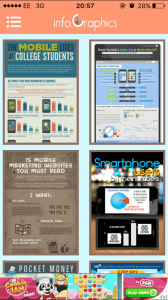I have been doing some research into infographics so I could get some inspiration and ideas flowing. I’ve been looking at examples on www.customermagnetism.com/infographics/ which has a variety of different infographics to show.
 I liked this one as it proved to me how effective infographics are by explaining very clearly what they are. I like the design and how it continues down the page – it shows that infographics can be very flexible in this way and don’t need to be a set size. The information displayed is minimal and yet useful – which shows me that I don’t need to go completely in depth with it. I can include quotes, statistics (displayed as graphs, charts, through imagery, etc), colour and images. I do like the style of this infographics, which has been presented in a grid fashion, but I think I would like mine to be less precise in this way. I will try grids but I would rather not use this layout. I have a colour scheme in mind, which I can see from this infographic is important to keep a balance and make the vast amount of information easier to read and comprehend.
I liked this one as it proved to me how effective infographics are by explaining very clearly what they are. I like the design and how it continues down the page – it shows that infographics can be very flexible in this way and don’t need to be a set size. The information displayed is minimal and yet useful – which shows me that I don’t need to go completely in depth with it. I can include quotes, statistics (displayed as graphs, charts, through imagery, etc), colour and images. I do like the style of this infographics, which has been presented in a grid fashion, but I think I would like mine to be less precise in this way. I will try grids but I would rather not use this layout. I have a colour scheme in mind, which I can see from this infographic is important to keep a balance and make the vast amount of information easier to read and comprehend.
I also had a look on this website – www.informationisbeautiful.net which gave me a good insight into different ways of displaying information so that it is visually pleasing but also how to make it interactive. For example: ‘Non-Fiction Books Everyone Should Read’ – this infographic names different book titles in a creative design and when you click on each title it leads you to a website where you can buy it. I won’t be able to do this myself, but I can always explain what the infographic would be like when online.
Existing ‘Theory of Relativity’ Infographics
I had a look at what infographics for the theory of relativity are already out there to see how I could make mine different but also to get some inspiration and knowledge. After googling ‘theory of relativity infographics’ I was soon able to pick out which I liked and disliked –
 I really liked this infographic (<— click), which helped to explain the theory to me. It’s got a lot going on visually but in a good way that keeps you interested. I feel like the length of the infographic helps to spread out the information. As you cannot see it all at once it breaks it up a lot more and makes it simpler for the audience. The layout is split into sections which I like, but I also want to have a go and mixing the layout around and overlapping sections to see how this would look too.
I really liked this infographic (<— click), which helped to explain the theory to me. It’s got a lot going on visually but in a good way that keeps you interested. I feel like the length of the infographic helps to spread out the information. As you cannot see it all at once it breaks it up a lot more and makes it simpler for the audience. The layout is split into sections which I like, but I also want to have a go and mixing the layout around and overlapping sections to see how this would look too.

I both like and dislike this infographic. I do like how you can see all of the infographic on your screen without scrolling down or across because it helps to show off the overall design involved such as the colour scheme. However, the colour scheme is one of the things I don’t like. It’s too dull in my opinion and the typeface used is very boring. I think this infographic was probably made for an older target audience and perhaps someone who is very interested in the subject, perhaps a physics student. It’s not the kind of style I would use in my own.

I can definitely say I don’t like this one as its just too plain and boring. The typeface is plain, simple, boring and dull. There is not a lot going on visually with very basic images. The colours do not allow anything to stand out. It makes the information as boring as the way it is presented which is not what an infographic should do.
Looking at these infographics has given me a good idea of what I want to do and what I definitely do not want to do. Now I need to research more into the theory itself so I know what information to present.






